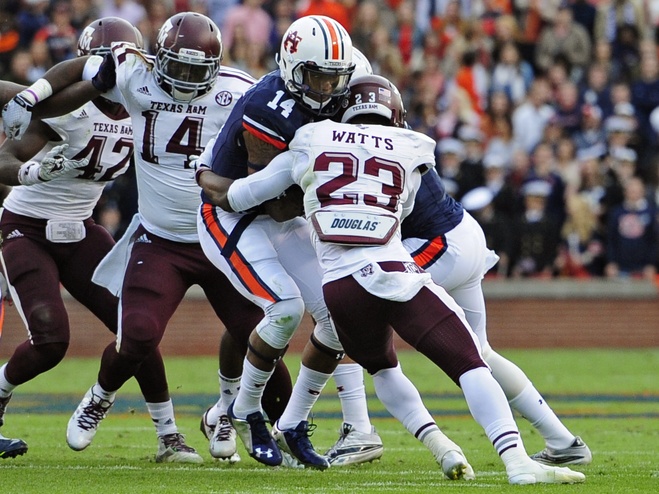Armani Watts: Can John Chavis turn him into a football player?
Texas A&M’s problems on defense can’t be isolated to any one position or skill. New defensive coordinator John Chavis won’t have much time to enjoy his new surroundings in College Station this spring.
But considering his blueprints at LSU and the emerging talent at defensive line, the secondary is a great place to start.
ESPN ranked the Aggies secondary 14th in the SEC in its pre-spring position rankings, but begrudgingly labeled Armani Watts as a “potential star.”
Watts, a former four-star recruit, now is the team’s 5-foot-11, 190-pound starting free safety. He earned the job in fall camp of his true freshman season and performed relatively well, intercepting three passes and breaking up eight others. His coverage skills — specifically his ability to track the ball in the air and his ball skills as a former receiver — are his best assets, and he’d probably be a cornerback if he was a little faster.
Watching him closely throughout the 2014 season, one big negative emerged: Watts seemed terrified to lower his shoulder and slam into opposing ball-carriers, or even sprint at full speed into the scrum of bodies during running plays. Based on his high school highlights and recruiting evaluations, he’s got the aptitude to be an all-around safety. But last season he played obnoxiously soft against the run.
There won’t be a more talented player than Watts in the A&M secondary in ’15, all due respect to De’Vante Harris. Watts did make 59 tackles last season, but keep in mind that since-departed cornerback Deshazor Everett made 79 on the same defense.
The Aggies could take advantage of Watts’ coverage skills by moving him to nickelback in packages with five defensive backs. That’s the position A&M initially envisioned for him, and he’s gotten some work inside during pre-season workouts.
So Chavis’ first priority in the secondary should be determining the best spot for Watts’ skill set, whether it’s remaining at free safety, switching inside full-time or playing a combination of both depending on down and distance.
But let’s not kid ourselves. The best thing Chavis can do is turn Watts from an athlete who plays football into a football player.
The defensive coordinator with the mangy mustache is a no-nonsense man. He’s not the most charismatic assistant coach in the SEC, one of the reasons he’s not a major player in recruiting, but he does a great job relating to players. He’s more of a teacher than a salesman.
Chavis has a knack for developing athletic, relatively small coverage defensive backs who aren’t afraid to stick their faces into the chests of much bigger players. Think Tyrann Mathieu and Morris Claiborne, both of whom incidentally enjoyed breakout seasons as sophomores.
Perhaps Watts felt a bit intimidated as a true freshman in the SEC. Maybe he felt lost at times and that lack of confidence only came across as an unwillingness to hit. Whatever the case, if Watts possesses it inside him, Chavis should spend the spring trying to locate it, cultivate it and encourage it, either through drills on the field or in 1-on-1 conversations. The team needs Watts to turn into a hard-nosed, fearless hitter, or at least a willing participant in the run defense.
Texas A&M has some young talent at all three levels of the defense, and the Aggies could make a significant turnaround with the right development. But perhaps no single piece is as important to develop for the 2015 team as Watts.

